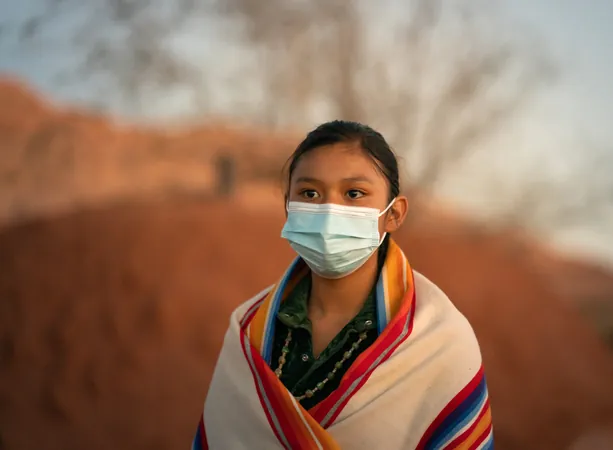
Bridging the Gap: Enhancing Health Outcomes for Indigenous Peoples
2024-12-02
Author: Michael
Bridging the Gap: Enhancing Health Outcomes for Indigenous Peoples
Indigenous Peoples around the globe face distinct challenges in accessing and asserting their right to healthcare. Lorna Rothery engaged in a critical dialogue with Dr. Sandra Del Pino, an Advisor on Cultural Diversity at the Pan American Health Organization (PAHO), to explore the intertwined realities of culture and health for these communities.
Historic Milestones in Indigenous Health
One of the most notable achievements in the health sector for Indigenous Peoples occurred in 2017 when all member states of PAHO collectively endorsed the first policy specifically addressing ethnicity and health. This landmark policy was a collaborative effort, emphasizing a shift from traditional, top-down health interventions to inclusive, participatory strategies. By directly involving Indigenous groups, people of African descent, and other ethnic communities, governments are now better equipped to identify and prioritize the public health concerns that matter most to them.
These collaborative efforts have opened avenues for tackling urgent health issues including maternal and infant mortality, tuberculosis, and other communicable diseases. This strategic shift acknowledges the need for health systems that are responsive to the unique cultural and social contexts of Indigenous populations.
Persistent Challenges in Realizing Health Rights
Despite these advancements, Indigenous communities continue to experience significant barriers. Historically marginalized from health initiatives, they often find themselves excluded from processes that directly affect their well-being. Discrimination remains pervasive, as some individuals encounter prejudice within healthcare settings—be it through dismissive attitudes regarding their traditional practices or overt biases against their cultural identity.
Furthermore, there exists a profound gap in understanding the health issues these groups face from their unique perspectives. Conventional data collection methods often overlook the nuances that define Indigenous lifestyles, beliefs, and practices. The ongoing effects of the COVID-19 pandemic starkly highlighted these disparities, propelled by vaccine hesitancy rooted in historical mistrust of external health authorities.
Knowledge Gaps and the Path to Healing
A critical examination of Indigenous health reveals significant knowledge gaps—particularly in data collection. Accurate health statistics are paramount for developing effective interventions. However, many health professionals lack training in culturally sensitive care, leaving Indigenous patients underserved and dissatisfied with their healthcare experiences.
To truly honor the health and healing practices of Indigenous Peoples, it is imperative to integrate traditional medicine and community health solutions into broader public health strategies. Sustainable development goals (SDGs) resonate deeply with this demographic, especially those concerned with reducing inequalities and promoting gender equality in health care.
Aligning Healthcare Initiatives with the Sustainable Development Goals
The Sustainable Development Goals (SDGs) serve as a robust framework for enhancing healthcare initiatives tailored to Indigenous needs. SDG 3 is pivotal, focusing on ensuring healthy lives for all individuals, while others aim to mitigate inequalities and uplift gender-specific health concerns. By embedding cultural competence into healthcare systems, we move toward more equitable health outcomes.
Human rights must serve as the foundation for addressing Indigenous health issues. This entails recognizing both collective and individual rights and ensuring active participation from Indigenous communities in the development of health strategies. Rather than imposing solutions, stakeholders must engage in genuine, respectful partnerships with these communities.
The Road Ahead: PAHO’s Elimination Initiative and Beyond
PAHO’s recently launched Elimination Initiative aims to eradicate over 30 communicable diseases across the Americas by 2030. This comprehensive approach emphasizes strengthening health systems and engaging multisectoral resources, while also acknowledging the socio-environmental determinants crucial to health.
Although the pandemic posed setbacks, persistent challenges—such as migration, the rise of non-communicable diseases, and resource limitations—remain. Conversely, advancements in technology and health determination awareness offer new opportunities for addressing these obstacles.
Conclusion
In conclusion, healing the rift between health systems and Indigenous Peoples’ needs is a complex, but essential endeavor. By listening to and collaborating with Indigenous communities, the potential to reshape health care from a culturally sensitive perspective becomes not just a possibility, but a necessity. As we move forward, it’s clear that a one-size-fits-all approach will no longer suffice; instead, tailored solutions are paramount as we work towards inclusive health systems that celebrate and respect the diversity of Indigenous identity.









 Brasil (PT)
Brasil (PT)
 Canada (EN)
Canada (EN)
 Chile (ES)
Chile (ES)
 España (ES)
España (ES)
 France (FR)
France (FR)
 Hong Kong (EN)
Hong Kong (EN)
 Italia (IT)
Italia (IT)
 日本 (JA)
日本 (JA)
 Magyarország (HU)
Magyarország (HU)
 Norge (NO)
Norge (NO)
 Polska (PL)
Polska (PL)
 Schweiz (DE)
Schweiz (DE)
 Singapore (EN)
Singapore (EN)
 Sverige (SV)
Sverige (SV)
 Suomi (FI)
Suomi (FI)
 Türkiye (TR)
Türkiye (TR)